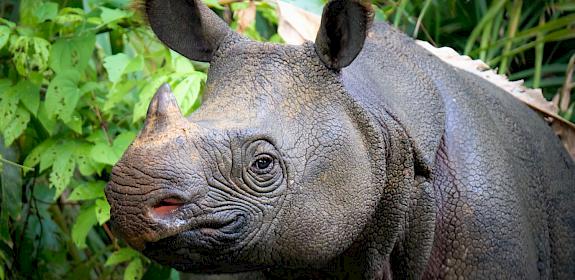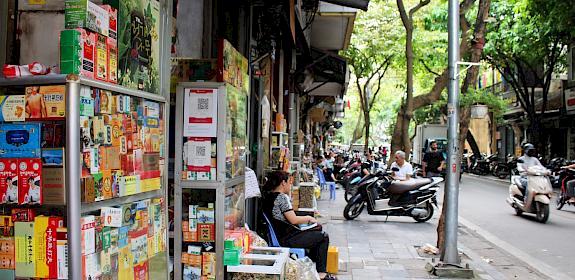
White rhino Ceratotherium simum grazing in Kruger National Park, South Africa © Christiaan van der Hoeven / WWF-Netherlands
i
African Black and White Rhino conservation
The conservation of African rhinos has been a major wildlife trade issue for well over a decade. The most pressing threat to their continued survival in the wild is from poaching to satisfy consumer demand for their horn, predominantly from Asia.
Currently, there are approximately 20,000 White Rhinos Ceratotherium simum on the continent, classified by IUCN as Near Threatened. Tragically, the last remaining wild population of the northern subspecies cottoni will soon become extinct as only two female captive individuals remain.
There are approximately 5,000 Black Rhinos still in Africa, classified as Critically Endangered by IUCN, with three surviving subspecies: Eastern Black Diceros b. michaeli, South-central Black D. b. minor and South-western Black D. b. bicornis. The Western Black subspecies D. b. longipes was confirmed extinct in November 2011. Increased enforcement and policy action is urgently needed to prevent remaining African rhino populations moving further towards extinction.
rhinos in Africa once numbered in the 100,000s
today, 3 are poached every day
Viet Nam
and China are the primary consumer markets for rhino horn
96%
of Black rhinos were poached between 1972 and 1996
2,149
rhino horns were seized by law enforcement agencies globally between 2010 and 2017
3 rhinos
are poached every day in South Africa alone
a background to the crisis
Most African rhinos are now found in South Africa, which hosts 79% of the continent’s total, alongside other important range States Namibia, Kenya, and Zimbabwe.
Our work takes us across these nations and beyond, including working with law enforcement on the ground to develop detection and forensics techniques, and helping governments develop policy agreements to help tackle a complicated and ruthless transnational illegal trade.
In 2017, TRAFFIC revealed disturbing new evidence that criminal networks of Chinese origin operating in South Africa were processing rhino horn locally into beads, bracelets, bangles and powder to evade detection and provide ready-made products to consumers in Asia, mainly in Viet Nam and China. The emergence of a new market in China is a particularly worrying development and poses increased challenges to already over-stretched law enforcement agencies.
rhino poaching in South Africa
From 1990 to 2007, South Africa lost an average of 13 rhinos to poaching each year; today, around 3 are lost there every day.
Although South Africa’s Kruger National Park has historically borne the brunt of this poaching onslaught, official figures since 2015 have revealed a steady, if marginal, decrease in illegal rhino killing within the park—2015 statistics showed 70% of rhinos poached in the country occurred in Kruger, compared to 60% in 2017.
Rather than reflect a significant downward trend in the numbers of rhinos killed in South Africa, this decrease has been offset by increases in reported poaching elsewhere, most notably in KwaZulu National Park, amid allegations of corruption.
Official statistics for rhino poaching in South Africa © TRAFFIC
i
the demand that drives rhino poaching
Since TRAFFIC's ground-breaking report in 2013, we have been at the forefront of understanding consumer demand for rhino horn—which drives the rhino poaching crisis.
There is a strong link between this demand and the growth of wealthy, urban middle classes, particularly within Viet Nam, where such a commodity is regarded as a status symbol and given as a gift to those in authority. There is also the belief that rhino horn can be used to cure a variety of ailments including cancer, thus enhancing demand further.
As countries attain higher levels of economic development, it is likely that the demand for rhino horn may in fact increase.
related reports to RHINOS
Explore the latest publications, reports and papers from TRAFFIC related to rhino conservation and trade in rhino horn.
Visit our resource library for the full TRAFFIC publication archive.

ROUTES
The Reducing Opportunities for Unlawful Transport of Endangered Species (ROUTES) Partnership brings together government agencies, transportation and logistics industry companies and representatives, international conservation, development and law enforcement organizations and donors in order to disrupt wildlife trafficking by air.

ReTTA
Reducing Trade Threats to Africa's wild species and ecosystems works to identify species most at risk from illegal trade and develop solutions to reduce the availability and opportunity for poaching to occur as well as the efficiency and effectiveness of law enforcement agencies.
changing policy and ongoing work : a timeline
Since TRAFFIC first flagged the alarming rise in rhino poaching we have stayed on the frontline of defence by monitoring evolving trade trends and facilitating direct action by governments, organisations, agencies and decision-makers to combat poaching and trafficking.









